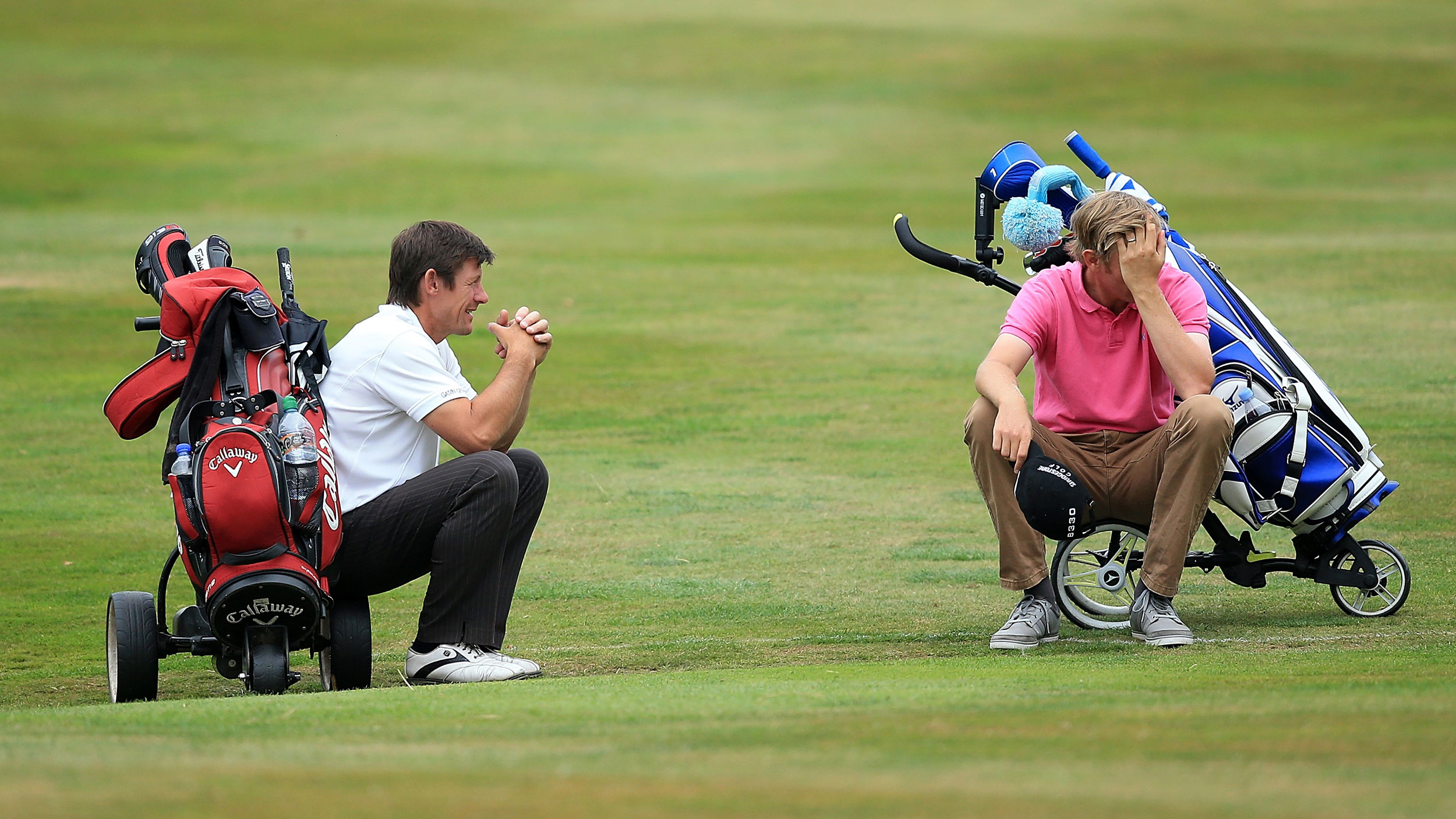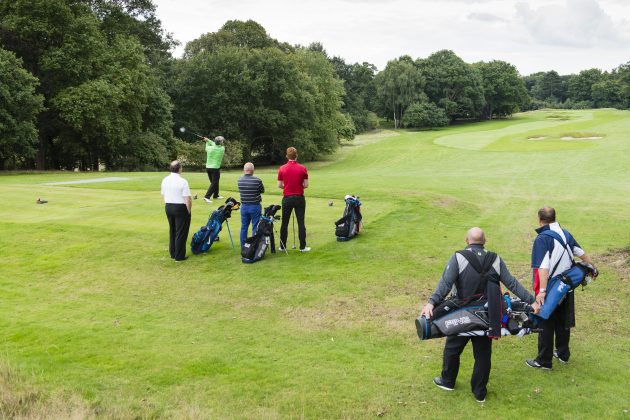11 Ways To Improve Golf's Pace Of Play
The pace of play is one of the most frequent gripes golfers have. So what can be done to speed things up?


11 Ways To Improve Golf's Pace Of Play
Slow play is one of the biggest bugbears of golf. We all want to get round in a reasonable time, as many of us have busy lives. Also, when weather is cold or inclement, the less time spent out in it the better. Plus, slow play means lots of standing around and golf can become harder when you lose the momentum of a round.
Most dyed-in-the-wool golfers are probably in too deep with the game to be driven away. But the longer rounds become, the fewer number of golfers can get out on the course, which has a knock-on effect on the amount of tee times available on a day, the amount of players who can enter a competition, and even the amount of members a club can accommodate.
So what can be done? We’ve all read lists of contributing factors as long as our arms, and the accompanying series of ‘beating slow play’ videos at the bottom of the page takes a closer look at what we feel to be the main causes, along with one or two practical solutions. Some are down to player behaviour and awareness, others to the club or course manager, for there are some factors at play over which individual player has little or no control.
Be ready to pay when it’s your turn
We feel that one of the biggest causes of slow play is the golfer simply not being ready to play when it is his or her turn on tee, fairway or green, or when the course ahead is clear. Golf is not a race, so you don’t have to be relentless in your pursuit of the finishing post. But you do need to be ready to go as soon as it’s your turn rather than a minute afterwards, to prevent unnecessary frustration for others in your group and all those behind you.
GM advises
Start assessing your approach shot as you are walking to the ball, then have your distance measured, club selected, glove on and shot planned out while others are playing, rather than starting the whole process after they have played. There may be times when you can’t do all of this as you’re on someone else’s line or close enough to distract them, but often you will far enough away to able to do everything well ahead of your shot. On the putting green you can get a general idea or your read when first approaching the green, and again, as long as it doesn’t distract anyone, you can be working on your line while others are putting. Don’t wait until it is your turn to start the whole process.
Subscribe to the Golf Monthly newsletter to stay up to date with all the latest tour news, equipment news, reviews, head-to-heads and buyer’s guides from our team of experienced experts.
Keep pre-shot routines in check
We will all have played with people whose pre-shot routines go on forever, and will probably all have started to walk on a practice swing we had wrongly assumed simply must be the real thing! If your routine involves assessing the yardage, carefully selecting your club, standing behind the ball with club out in front of you, partial practice swings away from the ball to groove key moves, then three more adjacent to the ball before finally hitting, you’re unlikely to be the most popular playing companion at your club, and unlikely to be helping overall pace of play.
GM advises
We all want to give ourselves the best chance of playing to our potential, and instructional advice seems to increasingly advocate an ordered pre-shot preparation. But there has to be some sort of balance. By all means adopt a routine before hitting, but not to a degree that might adversely affect others. Is there any part of your routine you could be doing while others are playing, or you could condense down to a level where the benefits to you are not at the cost of the enjoyment of others?
Related: Eddie Pepperel on slow play - "Nothing needs to change"

If in doubt, play a provisional ball
Of all the scenarios covered here, this one probably has the greatest potential to impact adversely on round times. Rule 27-2 specifically allows you to follow a procedure that will keep delays to a minimum when you’ve hit your ball offline. Yet golfers often spurn the chance to do so, perhaps out of frustration or a refusal to accept that they might be in trouble. But if you don’t take a provisional ball and can’t then find the original, the impact on your group’s round time could be 10 to 15 minutes, factoring in the five-minute search and the long walk back. There will be a negative impact on all those behind you too, other than the group waved through.
GM advises
Adapt your provisional ball strategy to err more on the side of caution, so if there is any doubt at all, or no-one has really seen it even if you think it should be okay, play a provisional. It really is a case of ‘nothing lost!’ By all means, listen to what others say about whether they’ve seen it land and where, but if you’re unconvinced, for the sake of another 20 seconds, play a provisional ball to keep to an absolute minimum any risk of you having to do the long walk back. The new Local Rule available from January 1st 2019 allowing players to drop back in play from OOB under a two-stroke penalty could also help here when adopted.
The etiquette section in the Rules of Golf requires slower groups to wave faster groups through, yet often this doesn’t happen. Golfers seem reluctant to be overtaken, and we’ve all probably watched the group ahead start running between shots rather than waving us through. Similarly, if it comes at all, the call-through when players are searching for a ball seems to often come too late to be of any real pace of play benefit.
GM advises
Don’t be embarrassed to wave people through if they are clearly playing faster than you and the course ahead is clear. Nobody really likes feeling hassled, and nobody really likes being held up. The whole scenario is not quite as straightforward as some make it out to be, as on a busy course, constant waving through will only ever impact negatively on those further down the field. But on a less busy course, waving faster groups through sooner rather than later keeps everyone happy – they’re off and away, while you no longer have someone breathing down your neck. If you can’t find your ball and the hole ahead is clear, call those behind through early in the search rather than waiting nearly five minutes to do so. And don't forget that from January 1 2019, it will only be a three-minute search in another move by the R&A to address pace of play concerns via the Rules.
A lot can go wrong at the green in terms of pace of play, and it’s doubly frustrating for those behind to have to witness the whole laborious process if the course beyond is clear. We’ve already covered being ready to putt when it’s your turn, but golfers will often leave their clubs in the wrong place for a speedy exit when everyone has putted out; they may cause delays by not taking their putter with them if they have to chip before putting; or they may even stand on the green totting up their score and marking their card while those on the fairway are waiting to play into the green.
GM advises
Find the exit point and try whenever possible to leave your bag there so you can head straight off when everyone has putted out, rather than adding in another 70-80 yard round trip. If you have to chip and putt, other than in very wet weather, take your putter with you, rather than chipping then walking back to fetch your putter. Never mark your card on the green if others are waiting to play in, and don’t leave whoever is last to hole out to also replace the flag - someone else should have it in hand ready to pop back in.
We’ve separated this one out from our general ‘not being ready’ as it’s such a common occurrence. A group will arrive at the next tee, then spend a minute or two sorting out the scorecards rather than anyone actually stepping up and hitting a ball. Again, all the more frustrating if the group behind has to watch this being acted out with a clear fairway or green beyond!
GM advises
If it’s clear to play, the only priority on the next tee is for the person with the honour to be ready to hit – or anyone if you’re playing ‘ready golf’ and someone else is ready to go first. There’s plenty of time to mark cards while others are hitting. So if you know it’s you to go first, have your glove on ready to tee it up as soon as you get there.
Not watching where you've hit it
Golf is a frustrating game, which can push us to the very edge. A bad shot at a crucial moment can be almost too much to bear sometimes, and rather than following the errant shot closely, it’s all too easy to spin away in disgust, frustrated by our own inability. Unfortunately, it’s at just such times that we are best served by following the ball as closely as possible to give ourselves the best chance of finding it and keeping any dropped shots to a minimum. It’s also not in the best interests of the field behind if we have to spend some time looking for a ball we didn’t really follow, and possibly even traipsing back to the tee if we neglected to play a provisional.
GM advises
Resist any temptation to turn away in dismay when you’ve sprayed one offline and try to follow the ball closely for any clues as to where it might end up. Did you see it down; did it bounce; which tree did it land closest to? You can’t do any of this of you’re wheeling away in disgust! If you’re playing into the sun, ask others to help follow the ball as you may struggle to pick up its flight. And don’t be embarrassed to run to the end of the tee post-impact if it will give you a better view of the ball’s flight.
Set the course up to be playable
Course set-up can have a significant bearing on pace of play, yet some courses are set up for midweek play as though the club is anticipating an influx of tour pros rather than mid to high-handicappers! Most of us find the game hard enough without having to contend with a course set-up that will either see us taking more shots or spending more time looking for balls. Long rough too close to the playing lines can be a big problem. There seems to be a growing obsession with ultra-fast greens, even though many older clubs’ greens were never designed to be played at such a pace. Some clubs lose sight of ‘six easy, six medium, six tough’ when it comes to pin positions resulting in too many missed greens and much three-putting, both of which will only slow things down.
GM advises
Given concerns about participation, it must be time to move away from a mindset of seeking to create a stern challenge, and set things up more to encourage, or even flatter, golfers rather than demoralise them. Overly long rough will only ever slow play down – why not cut it back more where it’s closest to the playing lines? Keeping the ground relatively clear beneath the trees is a sensible approach from a pace of play perspective, as the golfer is still suitably punished by having to chip out sideways or attempt a risky escape, but there is no time wasted in searching for balls, or working out where best to take a drop. More pins in accessible positions will reduce the number of missed greens and three-putts. Slightly less lively green speeds, especially on undulating surfaces, will result in less putting action. We want the game to remain a challenge, but it already is for most of us, and with slow play a growing problem, maybe now is the time to shift the balance back in favour of a more universally playable course set-up?

When we shot the accompanying videos to this feature at Burhill in Surrey, a notice on the 1st tee about expected round times confirmed what we all know – twos and fours are a bad mix when it comes to pace of play. The anticipated difference at Burhill is 40 minutes, and that’s a lot of time standing around waiting if, for whatever reason, twoballs are unable to get through the fourballs ahead.
GM advises
The standard call-through convention works well on a less busy course, but is not so effective for the overall good of all those out there when the course is busy and twos end up being sandwiched between fours who can’t go anywhere. If course geography allows, a two-tee start, keeping groups of different sizes apart for as long as possible, goes some way to remedying things. Even if twos then run into fours halfway round at crossover times, at least only one half of the round will have been slow. Alternatively, having set times when only twos can tee off is a good idea.
Poor course signage leads to confusion and can adversely affect pace of play, whether it’s a lack of ‘next tee’ signs, or call-up holes not being flagged up obviously. Not having a ‘next tee’ sign behind a green where it isn’t immediately obvious is a double negative – golfers won’t know where best to leave their bags before putting, and won’t then be sure of where to go afterwards. Some courses have bell holes that aren’t signed from the tee; others have holes crying out for a bell, where the only way to really play safely is to walk a long way forward to doublecheck.
GM advises
Members may not understand what all the fuss is about, but far better to think about signage from the perspective of a first-time visitor. Is it always obvious where to go next as you navigate the course, especially where there is scope for confusion? ‘Next tee’ signs are essential when it’s not immediately obvious, where several tees lie close together, or particularly when the tee that seems to be the most obvious candidate isn't actually the next one. ‘Call-up’ holes or blind holes with a bell are a good idea, but the good work will be undone if it isn’t immediately clear to everyone what the procedure is. A bell hole without a notice on the tee means nothing to a first-time visitor – every tee from which a visitor might play needs to have a very obvious sign. If a hole is crying out for a bell for safety reasons, put one in with appropriate signage on the tee.
Despite the arrival of GPS devices and rangefinders, many golfers are still happy with a cursory glance at the 150-yard marker. Not having them can slow play down for those who haven’t made the technological leap, especially if sprinkler head yardages are miles apart. If yardages are only found on sprinklers heads, time can often be wasted locating the nearest one, or by players forgetting to glance at the closest one on the way to their ball.
GM advises
Installing or retaining discrete, yet obvious, distance markers can only ever help when it comes to pace of play as they are still more than adequate for golfers perfectly content with rough, rather than ultra-precise, yardages. However, if a golfer has reached the stage where he or she can only play confidently with a precise yardage, then it’s probably time to invest. Yes, it’s perfectly within the Rules to obtain distance information from another player with such a device, but that will wear thin after a while, and is unlikely to be something a matchplay opponent or arch strokeplay rival is eager to provide willingly!
The Golf Monthly Pace of Play video playlist...
We hope that our series of video stories might go some small way to shaving a few minutes off round times either through golfers modifying their behavior just a little, or clubs having a slight rethink in one or two areas…
- Players not being ready to play when the course is clear or it's their turn
- Elaborate pre-shot routines that take too long
- Players not calling faster golfers through soon enough
- General greenside etiquette
- Not playing a provisional ball when the original is in some doubt
- Not following or watching offline shots closely enough
- Marking cards on tees when someone should be hitting
In addition, we have a further four videos looking at issues which might require a rethink on the part of the club, committee or course manager. These address…

Jeremy Ellwood has worked in the golf industry since 1993 and for Golf Monthly since 2002 when he started out as equipment editor. He is now a freelance journalist writing mainly for Golf Monthly. He is an expert on the Rules of Golf having qualified through an R&A course to become a golf referee. He is a senior panelist for Golf Monthly's Top 100 UK & Ireland Course Rankings and has played all of the Top 100 plus 91 of the Next 100, making him well-qualified when it comes to assessing and comparing our premier golf courses. He has now played 1,000 golf courses worldwide in 35 countries, from the humblest of nine-holers in the Scottish Highlands to the very grandest of international golf resorts. He reached the 1,000 mark on his 60th birthday in October 2023 on Vale do Lobo's Ocean course. Put him on a links course anywhere and he will be blissfully content.
Jezz can be contacted via Twitter - @JezzEllwoodGolf
Jeremy is currently playing...
Driver: Ping G425 LST 10.5˚ (draw setting), Mitsubishi Tensei AV Orange 55 S shaft
3 wood: Srixon ZX, EvenFlow Riptide 6.0 S 50g shaft
Hybrid: Ping G425 17˚, Mitsubishi Tensei CK Pro Orange 80 S shaft
Irons 3- to 8-iron: Ping i525, True Temper Dynamic Gold 105 R300 shafts
Irons 9-iron and PW: Honma TWorld TW747Vx, Nippon NS Pro regular shaft
Wedges: Ping Glide 4.0 50˚ and 54˚, 12˚ bounce, True Temper Dynamic Gold 105 R300 shafts
Putter: Kramski HPP 325
Ball: Any premium ball I can find in a charity shop or similar (or out on the course!)